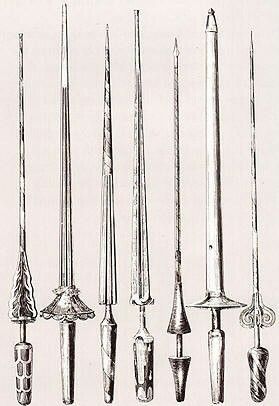
A lance is a pole weapon used by a mounted warrior or cavalry soldier.
It is longer, stouter and heavier than an infantry spear, and unsuited for throwing, or for rapid thrusting.
Lances did not have tips designed to intentionally break off or bend, unlike many throwing weapons of the spear/javelin family. They were often equipped with a vamplate, a small circular plate to prevent the hand sliding up the shaft upon impact.
Though perhaps most known as one of the foremost military and sporting weapons used by European knights, the use of lances was spread throughout the Old World wherever mounts were available.

Its employment can be traced to the ancient Assyrians and Egyptians, and it was widely used by the Greeks and Romans, despite their lack of the stirrup, which did not appear until the 6th century AD.
The Byzantine cavalry used lances almost exclusively, often in assorted mounted archer and lancer formations. The Byzantines used lances in both overarm and underarm grips, as well as being couched under the arm. The length of the standard kontarion is estimated at about 2.5 meters (8.2 ft), which is shorter than that of the medieval knight of Western Europe.
The lance was a popular weapon with medieval knights who used the lance weapon in battles and in friendly jousting competitions in medieval tournaments. In jousting, the lance tips would usually be blunt, often spread out like a cup or furniture foot, to provide a wider impact surface designed to unseat the opposing rider without spearing him through. They were on average 3 meters (9.8 ft) long, and had hand guards built into the lance, often tapering for a considerable portion of the weapon’s length.
In war, lances were usually long, balanced for one-handed use, and with sharpened tips. Groups of knights in full-gallop closed-ranks used underarm-couched lances against lines of infantry, archery regiments,
defensive embankments, and opposition cavalry.
The mounted lancer experienced a renaissance in the 17th century. This followed on the demise of the pike and of body armor during the early 18th century, with the reintroduction of lances coming from Poland and Hungary. In both countries formations of lance-armed cavalry had been retained when they disappeared elsewhere in Europe. Lancers became especially prevalent during and after the Napoleonic Wars: a period when almost all the major European powers reintroduced the lance into their respective cavalry arsenals.
The lance was carried by the cavalry of all the principal European armies through the 19th century, largely because there was no rigorous test of its effectiveness in the face of long-range musket or rifle fire. Part of its appeal lay in its contribution to peacetime military pageantry.
The Franco-Prussian War of 1870 saw the extensive deployment of cavalry armed with lances on both sides. While the opportunities for using this weapon effectively proved infrequent during the actual conflict, the entire cavalry corps (hussars, dragoons, cuirassiers, and uhlans) of the post-war Imperial German Army subsequently adopted the lance as a primary weapon. After 1893 the standard German cavalry lance was made of drawn tubular steel, covered with clear lacquer and with a hemp hand-grip. At 3.58 meters (11.7 ft) it was the longest version then in use.
In 1889, despite the indifferent success of lancers in the Franco-German War, Germany converted all of its remaining cavalry regiments into lancers known as Uhlans. In 1914 they briefly carried their antique weapons into a machine-gun war, as did the British and French—men were run through with lances at the first Battle of the Marne.
Through hard experience, the general staffs of Europe eventually (and reluctantly) conceded that a charge of lancers or any other cavalry contingent could easily be mowed down by machine-gun fire before reaching the defenders’ lines. And so by the 1920s the lance had quietly faded out of the Western armory. The lance made an anachronistic battlefield appearance in the hands of Polish cavalrymen who charged German columns in September 1939, at the beginning of World War II, with some success.
The United States Cavalry used a lance-like shaft as a flagstaff.
The world’s oldest continuous mounted police unit in the world, being the New South Wales Mounted Police, housed at Redfern Barracks, Sydney, Australia, carries a lance with a navy blue and white pennant in all ceremonial occasions.

The name “lance” is derived from the word lancea – the Roman auxiliaries’ javelin or throwing spear – although according to the OED, the word may be of Iberian origin. Also compare λόγχη (lónkhē), a Greek term for “spear” or “lance”.
Raymond Janin (France) held a jousting lance measuring 2.8 m (9 ft 2.16 in) long and weighing 3 kg (6 lb 8.53 oz) horizontally at shoulder height for 26 seconds on the set of L’Ete De Tous Les Records, Sete, France on 21 August 2003. Previously known as “Joust lifting – duration”.


